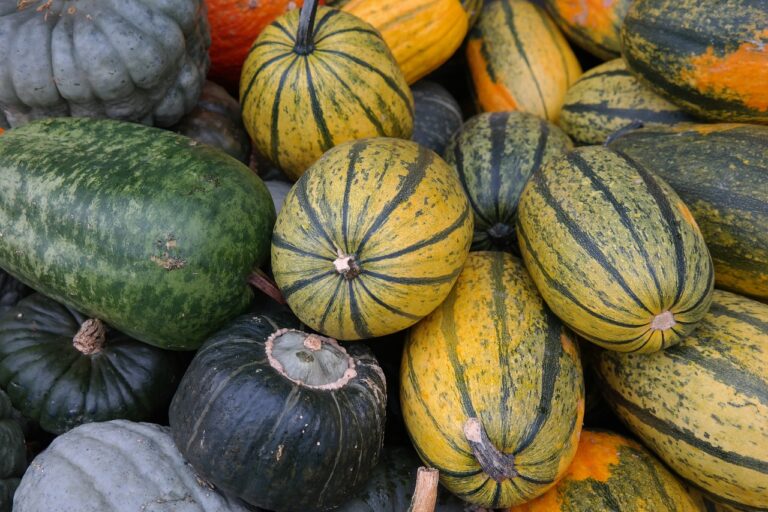Guide to Growing Squash in Pots
Growing squash in pots requires careful planning. Choose a 5-gallon pot, ensuring ample root space. Opt for containers with good drainage to prevent waterlogging. Improve soil with compost and maintain pH levels between 6.5 to 7. Place pots in sunny locations, providing 6 to 8 hours of sunlight daily. Plant seeds 1 inch deep, fertilize after six weeks, and water consistently, aiming for 1 inch per week. Keep an eye out for pests like squash bugs and powdery mildew. Benefits of pot-growing include space-saving and ease of pest management. For a bountiful squash harvest, focus on these essentials.
Selecting the Right Container Size
When selecting the proper container size for cultivating squash in pots, choose a 5-gallon pot for one plant to allow ample space for root development. Squash plants require sufficient room for their roots to spread out and access nutrients for healthy growth. By picking a container that is too small, you risk hindering the root growth and limiting the overall potential yield of the plant. Insufficient space can lead to root-bound plants, where the roots become tangled and struggle to absorb water and nutrients effectively from the soil.
The container size plays a crucial role in the success of growing squash in pots. A 5-gallon pot provides sufficient room for the roots to establish and grow without constraints. It also allows for proper soil moisture retention, ensuring that the plant receives the necessary hydration for ideal development. Additionally, the right container size promotes air circulation around the roots, preventing issues such as root rot and fungal diseases that can hinder the plant’s growth.
Choosing the correct container size is a foundational step in creating an ideal environment for squash plants to thrive. It directly impacts the plant’s ability to absorb nutrients, water, and oxygen, all essential elements for healthy growth and a bountiful yield. By prioritizing the right container size, you set your squash plants up for success from the start.
Soil Preparation and Ph Considerations
To guarantee perfect growth of squash plants in containers, it is essential to prepare nutrient-rich soil by enhancing garden soil with organic matter, compost, and maintaining a pH range of 6.5 to 7. When growing squash in pots, the foundation of success lies in the quality of the soil. Begin by amending your garden soil with rich organic matter and compost to provide essential nutrients for the plants. Layer a mix of premium raised bed soil, worm castings, compost, and potting mix to create a nutrient-rich environment that supports healthy growth.
The pH of the soil is equally vital, as it influences the availability of nutrients to the plants. Aim for a pH range between 6.5 to 7, which is slightly acidic to neutral, to ensure the best nutrient uptake by the squash plants. Testing the pH of your soil before planting is advisable to make any necessary adjustments for the best results.
Healthy soil composition is key to providing the necessary support for squash plants in containers. Proper soil preparation sets the stage for successful growth and abundant harvests. By focusing on creating a nutrient-rich environment with the right pH levels, you are giving your squash plants the best possible start in their container garden.
Meeting Light and Temperature Needs
Ensuring abundant sunlight and maintaining ideal temperatures are essential factors for nurturing healthy squash plants in containers. Squash plants thrive in full sun, requiring 6 to 8 hours of direct sunlight daily for ideal growth. To meet these light requirements, place your squash container in a sunny spot that receives ample sunlight throughout the day. Good air circulation is also critical for preventing diseases and ensuring the plants receive adequate light.
In addition to light, maintaining suitable temperatures is crucial for the ideal growth of squash plants in pots. Aim for warm temperatures, ideally in the mid-70s or higher, to create the optimal growing conditions for your squash. It’s important to note that low temperatures can lead to stunted growth in squash plants, so monitor the temperature around your container carefully.
To help regulate temperatures and keep the soil moist, choose an optimal potting mix that provides good drainage while retaining moisture. Consider using an organic fertilizer to provide essential nutrients for your squash plants. Remember, soil temperature should be at least 60°F for successful seed germination in squash containers. By ensuring adequate light and suitable temperatures, you are setting your squash plants up for success in their container environment.
Planting and Fertilizing Squash Seeds
For successful germination of squash seeds in pots, plant them at a depth of 1 inch in the center of the pot. This depth provides the seeds with the essential environment for sprouting while making sure they have enough access to moisture. Confirm the potting soil you use is well-draining to prevent waterlogging, which could lead to seed rot. Good drainage is vital for the healthy growth of squash plants, as they are prone to root diseases in waterlogged conditions.
When planting squash seeds, it’s important to select a location that receives plenty of sunlight, as this will promote healthy growth and fruit production. Additionally, incorporating organic matter into the soil will give the seeds a solid start, providing them with necessary nutrients for their initial growth stages.
As the squash plants grow, you will notice two types of flowers: male and female flowers. The female flowers will develop into the fruit, while the male flowers play a significant role in pollination. To ensure a plentiful harvest, it’s vital to fertilize the squash plants with a high-phosphorus fertilizer after about six weeks. This will encourage strong root development and support vigorous fruit production. By amending the soil with nutrient-rich fertilizers, compost, or worm castings, you can maintain healthy growth throughout the plant’s lifecycle.
Proper Watering Techniques
Implementing a consistent watering schedule is essential for maintaining the ideal hydration levels of squash plants grown in pots. Squash plants generally require about 1 inch of water per week to thrive. To guarantee proper hydration, it’s important to water the soil directly at the base of the plants. Watering the plants in the morning is best as it allows them to absorb moisture throughout the day, promoting healthy growth.
When container gardening, incorporating appropriate watering techniques is key. To retain water and prevent evaporation, consider adding organic mulch around the base of the squash plants. This mulch acts as a barrier, helping the soil retain moisture and reducing the frequency of watering needed. Additionally, watering in the morning reduces the likelihood of fungal diseases, as the foliage has a chance to dry out during the day.
Maintaining a consistent watering schedule and using these techniques will assist in the proper hydration of squash plants. By providing adequate water and ensuring it reaches the roots effectively, you can prevent issues related to underwatering or overwatering. Following these guidelines will promote healthy growth and help your squash plants thrive in a container gardening setting.
Identifying and Managing Common Pests
To effectively manage common pests that can harm squash plants, it is vital to promptly identify and implement targeted control measures. When dealing with squash pests, such as squash vine borers, cucumber beetles, aphids, squash bugs, and powdery mildew, understanding their characteristics and the damage they cause is important for effective management. Here are some practical steps to help manage these pests:
- Squash Vine Borers: Look for eggs on squash stems and apply floating row covers early in the season to prevent adult moths from laying eggs. Remove and destroy any affected plant parts.
- Cucumber Beetles: Monitor for early signs of bacterial wilt, such as wilting vines, and hand-pick beetles off plants. Consider using insecticidal soap or neem oil for larger infestations.
- Aphids: Regularly inspect the underside of squash leaves for aphids and their honeydew. Use a strong spray of water to dislodge them or apply insecticidal soap if necessary.






